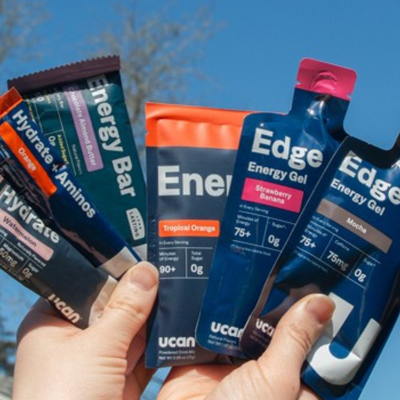By Kate Cohen
We’re all familiar with the afternoon slump. You're going about your day, feeling fine, but then 2 p.m. hits—and instead of thinking about a pre-dinner workout, you’re suddenly thinking about a pre-dinner nap. That’s about the time of day when many people’s blood sugar and energy levels drop. And while it’s natural for that level to change throughout the day, you don’t have to accept major dips and spikes as a given.
While your blood sugar level (the amount of glucose in your bloodstream) is impacted by many factors — including medications, stress, and your activity level—what you eat plays the biggest role. Keeping your blood glucose steady can benefit you both mentally and physically. One way to do this is to eat carbohydrate-rich foods with a good amount of fiber together with foods that contain protein and healthy fats, says Bob Seebohar, a board-certified specialist in sports dietetics and former sports dietitian for Olympic Team USA.
As soon as you eat carbs, your body starts working to break them down into glucose for energy. Simple carbohydrates that have added sugars or don’t have fiber (think cookies or white rice) are broken down much faster than complex high-fiber carbs. They give you a quick burst of energy but also lead to a quick crash. Protein and fat both take longer to digest than carbs and eating them helps slow down how quickly carbs raise your blood sugar.
How Your Diet Impacts Blood Sugar
Your body breaks down carbohydrates—found in grains, fruit, vegetables, milk, and sweets—into glucose. When glucose enters your bloodstream, the pancreas releases insulin to carry it to your cells so it can be used for energy. Any that is left over is stored in the liver and muscles to be used later on when your blood sugar gets low. “Sugar and processed carbohydrates have the largest effect on blood sugar,” says licensed and registered dietitian Julie Burns, an integrative sports nutritionist and team nutritionist for the Chicago Blackhawks.
When you eat too many processed carbs, your pancreas pumps out an increased amount of insulin to move the glucose from your blood into your cells. In the short term, that can cause your energy to surge and then crash. To compensate, the pancreas pumps out even more insulin to get blood sugar to your cells, but over time, your cells stop responding and can become insulin resistant. The pancreas keeps producing more insulin for these cells but eventually, it can’t keep up, so your blood sugar continues to rise. If this behavior goes unchecked, over time it can impair your body’s ability to regulate and use glucose for energy, which can increase the risk of developing Type 2 diabetes.
However, carbohydrates are a vital macronutrient, so you just need to be smart about the type of carbs you choose. These are the three main types:
Sugars
These simple carbohydrates break down very quickly, causing your blood glucose to rise sharply. They include the naturally occurring sugar in fruit and milk as well as the added sugar in foods and beverages like soda, sports drinks, candy, and ice cream, plus many processed foods containing white flour. Your body can’t tell the difference between natural and added sugars, but foods, like fruit—with natural sugars— usually also contain fiber and important micronutrients like vitamins and minerals. That’s why whole fruits are a smarter choice than fruit juices.
Starches
Most are complex carbohydrates, which are digested more slowly and contain vitamins and minerals. Starches are found mainly in fruits, vegetables, and grains, including black beans, lentils, apples, berries, brown rice, whole-wheat bread, corn, and peas, and when paired with fat and protein further slow down glucose absorption. There is also a type of starch called resistant starch that does not get broken down into glucose molecules in the small intestine. Therefore, it doesn’t increase blood sugar or insulin levels.
Fiber
Your body can’t break down this type of complex carbohydrate—found in fruits, vegetables, whole grains, nuts, seeds, beans, and legumes—so it won’t raise your blood glucose level or give you energy. Like healthy starches, fiber helps you feel full for a longer period of time. There are two types of fiber: soluble and insoluble. Soluble fiber dissolves in water and turns into a thick gel as it passes through your digestive system The gel slows down the digestion and absorption of fats, which helps keep your blood sugar levels from spiking. Insoluble fiber doesn’t dissolve in water but absorbs it. That makes it bulkier so that it can help move food through your digestive system.
10 Best Foods for Steady Blood Sugar
The most obvious reason to keep your blood sugar steady and controlled throughout the day is to avoid the risk of diabetes, Seebohar says. But it’s not the only reason. Blood sugar that’s too high or low can affect the body's energy usage, which can affect both physical performance and cognitive functioning, he says. Well-controlled blood sugar can make it easier to concentrate and make decisions, and it also may be good for your mood, as better mood and energy is associated with well-controlled blood sugar. Certain foods or combinations of foods are especially good at keeping your blood sugar steady. They’re also more likely to leave you feeling fuller—so you’ll be less likely to reach for a sweet or salty snack. Try adding the following to your diet:
1. UCAN’s LIVSTEADY™
This low-glycemic complex carbohydrate made from non-GMO corn starch provides steady, long-lasting energy and is available in UCAN products in the form of powders, granola, energy bars, and more. “The starch has been scientifically proven to stabilize blood sugar and doesn’t signal an insulin spike, which can improve your body’s ability to use fat for energy,” says Seebohar. For athletes and active people, this is an ideal choice to keep blood sugar steady instead of a sugary snack. Try the Edge energy gel or Energy Bars for a sustained energy boost on-the-go.
2. Avocados
Along with being creamy and versatile (you can add them to tacos or salads and spread them on toast), avocados are high in healthy monounsaturated and polyunsaturated fats and fiber. One recent study published in the journal Nutrients found meals in which fresh avocado was substituted for refined carbs increased participants' meal satisfaction and significantly suppressed hunger for six hours. Healthy fats can keep your blood glucose levels steady in a few ways. Unlike carbs, only a small portion of fats can be broken down into glucose. Your body also digests fats more slowly, so you don’t get quick spikes of energy as you do from simple carbs.
3. Salmon
Salmon is packed with protein—a 3-ounce portion has 17 grams, which is a third of the recommended daily value. Prioritizing protein is, hands down, the best blood sugar balancing and satiating nutrient you can eat, Burns says. That’s because protein breaks down more slowly than carbs and is more filling than either carbs or fats. Salmon is also high in healthy omega-3 fats. Research shows that eating salmon can lower post-meal blood glucose levels compared with eating leaner fish like cod.
4. Eggs
Eggs are almost pure protein, and the yolk is rich in vitamins and minerals. Research has found that people who ate eggs rather than a bagel for breakfast had more stable blood glucose and insulin levels, and they were also less hungry three hours after their meal.
5. Blueberries
Blueberries may be sweet, but they won’t raise your blood sugar as much as other fruits. They are high in fiber and also contain polyphenols, a type of compound found in certain plants. Research has found that polyphenols may help slow carbohydrate digestion and moderate how much glucose the liver releases into the bloodstream.
6. Nuts and seeds
Incorporating nuts and seeds (especially chia and flaxseed) into your diet is a great way to help manage and support healthy blood sugar levels, Burns says. They’re packed with omega-3s, polyphenols, protein, and healthy fats. They’re also portable and a simple, no-fuss snack.
7. Oats and oat bran
Unlike many cereal options, oats and oat bran are high in soluble fiber, says Amy Shapiro, a registered dietitian and founder of Real Nutrition in New York City. Steel-cut oats may be the best choice because they’re digested more slowly and have the least impact on blood sugar.
8. Pumpkin
If you’re a fan of pureed pumpkin or pumpkin seeds, look for opportunities to include them in your meals. “Pumpkin is a great choice for blood sugar regulation because it’s high in fiber and antioxidants,” Shapiro says. Pumpkin seeds are also high in healthy fats and protein, she adds.
9. Beans and lentils
They are rich in nutrients such as magnesium as well as insoluble fiber and protein, which may help lower blood glucose and improve blood sugar response after meals, Shapiro says.
10. Broccoli and broccoli sprouts
Broccoli and broccoli sprouts both contain sulforaphane, a natural chemical that may help protect against diabetes. Research shows that sulforaphane can reduce blood glucose levels and help prevent your cells from becoming insulin resistant.
More Ways to Manage Your Blood Sugar
While improving the quality of your diet is the most effective way to boost your energy naturally, there are other ways to help keep your blood glucose levels steady.
- Exercise regularly: It makes your body more sensitive to insulin so that glucose moves out of your blood and into your cells.
- Keep an eye on stress: When you feel stress—whether it’s because of life pressure or physical pain—your body releases the fight-or-flight hormones cortisol and adrenaline, which raise your blood sugar. Try proven stress-busters like exercise, meditation, and deep breathing.
- Stay hydrated: The less water in your body, the more concentrated your blood sugar is. You’ll know you’re drinking enough when your urine is light yellow. Try an electrolyte replacement with no sugar like UCAN Hydrate to prevent dehydration when exercising without packing on extra calories.
- Prioritize sleep: Not getting enough sleep can also increase the level of cortisol in your blood and your blood sugar. The Centers for Disease Control and Prevention says that even a single night of poor sleep can affect how well your body uses insulin.








